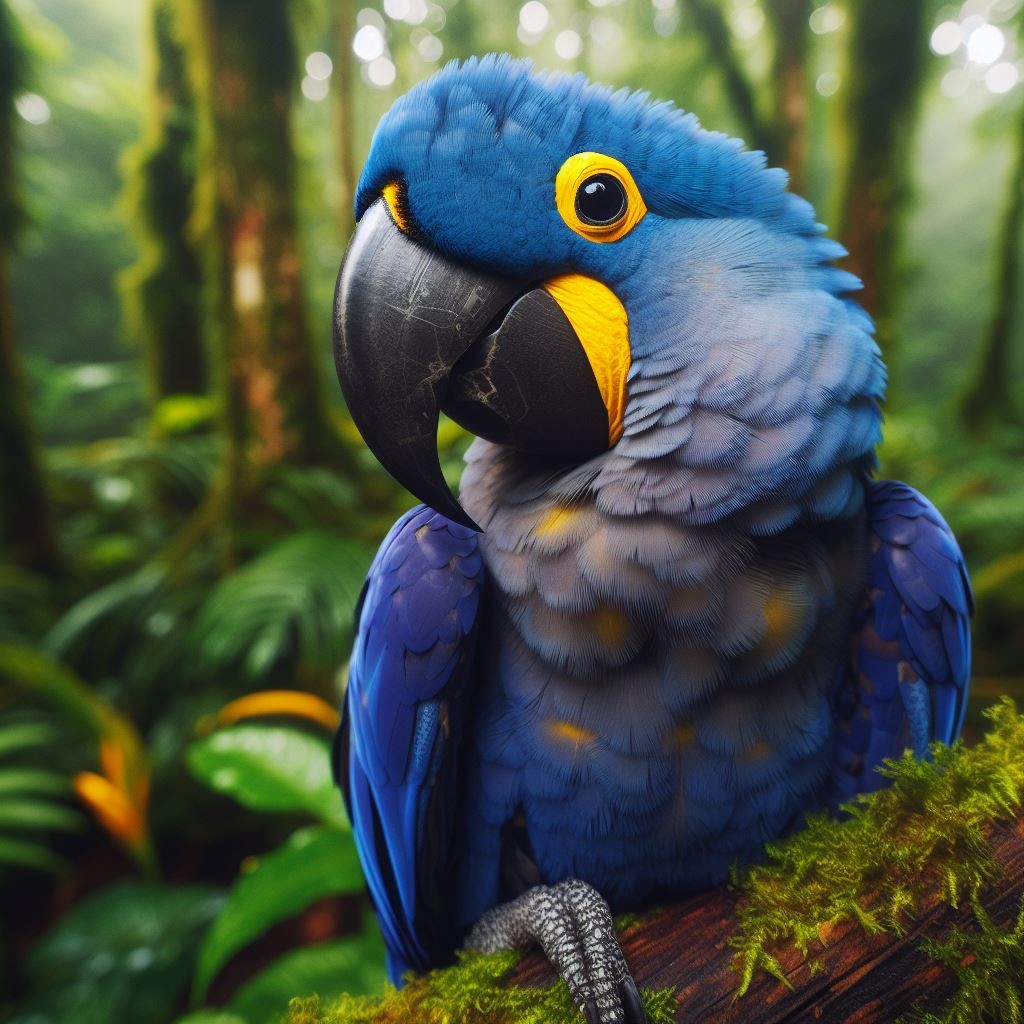The Hyacinth Macaw (Anodorhynchus hyacinthinus) is a breathtakingly beautiful parrot native to South America. With its vibrant blue feathers and massive size, it is often referred to as the “blue macaw” and is a favorite among bird enthusiasts and conservationists alike.

Physical Description
The Hyacinth Macaw is the largest flying parrot species in the world, measuring about 100 cm (3.3 ft) in length from the beak to the tip of the tail and weighing around 1.2-1.7 kg (2.6-3.7 lbs). Its most striking feature is its deep cobalt-blue plumage, which covers most of its body, with bright yellow markings around its eyes and beak. The Hyacinth Macaw also has a strong, hooked beak that is perfect for cracking open the hard shells of nuts and seeds.
Habitat and Distribution
These magnificent birds are native to central and eastern South America, specifically Brazil, Bolivia, and Paraguay. They inhabit a variety of environments, including savannas, palm swamps, and woodlands. However, due to habitat destruction and illegal trapping, their population has significantly declined, and they are now considered endangered.
Diet and Feeding Habits
Hyacinth Macaws primarily feed on nuts, seeds, and fruits, with a special preference for the nuts of the acuri palm tree. Their strong beaks allow them to crack open even the toughest nuts with ease. They play a crucial role in their ecosystem by dispersing seeds and helping to regenerate forests.
Behavior and Social Structure
These parrots are known for their sociable nature and are often seen in pairs or small family groups. They are highly intelligent birds and are capable of complex problem-solving tasks. They communicate with each other through loud squawks and screeches, which can be heard from a considerable distance.
Reproduction and Life Cycle
Breeding usually occurs between July and December, during the dry season in their native habitat. Hyacinth Macaws are monogamous and form strong bonds with their mates. The female typically lays 1-2 eggs, which are incubated for about a month before hatching. The chicks are cared for by both parents and fledge (grow feathers necessary for flight) in about 3-4 months.
Conservation Status
The Hyacinth Macaw is listed as endangered on the IUCN Red List of Threatened Species. The main threats to their survival are habitat loss due to deforestation, illegal pet trade, and hunting. Conservation efforts are underway to protect their remaining habitat and combat illegal trade.
Relationship with Humans
These stunning birds have been highly sought after as pets, leading to a significant decline in their wild population. However, due to their endangered status, owning a Hyacinth Macaw is highly regulated, and individuals are required to obtain special permits. Many conservation organizations are working tirelessly to raise awareness about the plight of these birds and to protect them in their natural habitat.
Common Myths and Misconceptions
There are several myths and misconceptions surrounding the Hyacinth Macaw, including the belief that they can mimic human speech like some other parrot species. However, their vocalizations are more limited, and they primarily communicate through squawks and calls.
Conclusion
The Hyacinth Macaw is a truly remarkable bird, both in its beauty and its ecological importance. As one of the largest flying parrots, it plays a vital role in its native ecosystem and deserves our utmost respect and protection. By raising awareness and supporting conservation efforts, we can ensure that future generations will still have the privilege of marveling at these magnificent creatures in the wild.
FAQs (Frequently Asked Questions)
- How long do Hyacinth Macaws live? Hyacinth Macaws can live up to 50 years or more in captivity with proper care and attention.
- Are Hyacinth Macaws good pets? While they are incredibly beautiful birds, Hyacinth Macaws require a lot of space, mental stimulation, and specialized care, making them challenging pets for most people.
- Why are Hyacinth Macaws endangered? The main threats to Hyacinth Macaws are habitat loss due to deforestation, illegal pet trade, and hunting.
- Can Hyacinth Macaws mimic human speech? While they are not as proficient at mimicking human speech as some other parrot species, Hyacinth Macaws can learn a few words and sounds with proper training.
- How can I help protect Hyacinth Macaws? You can help protect Hyacinth Macaws by supporting conservation organizations, raising awareness about their plight, and avoiding products made from illegally harvested palm nuts.






